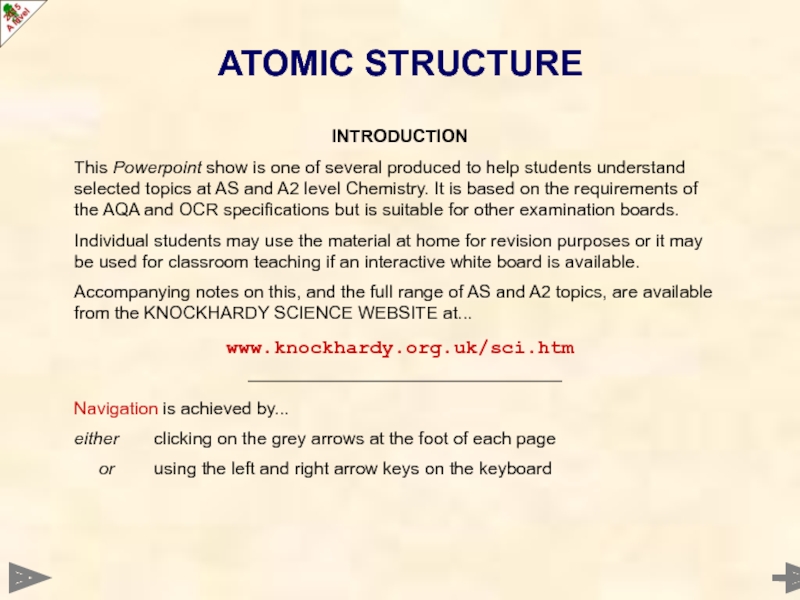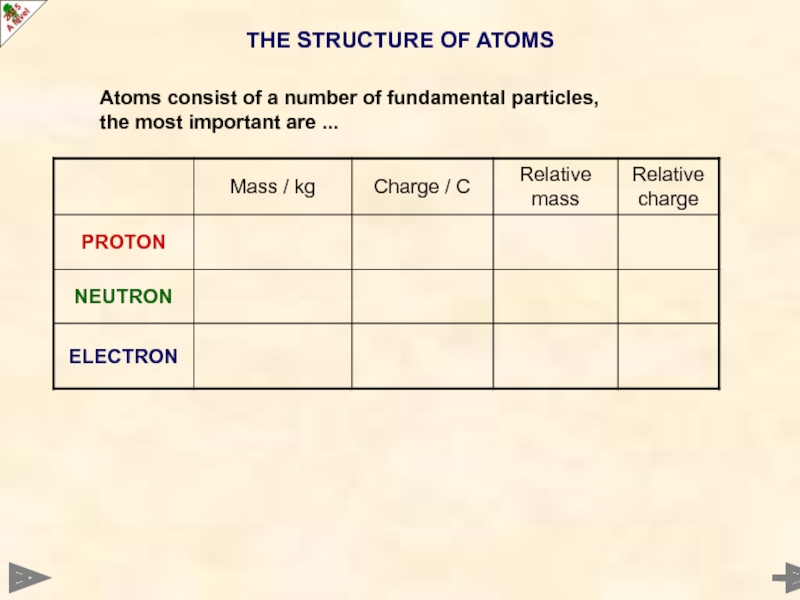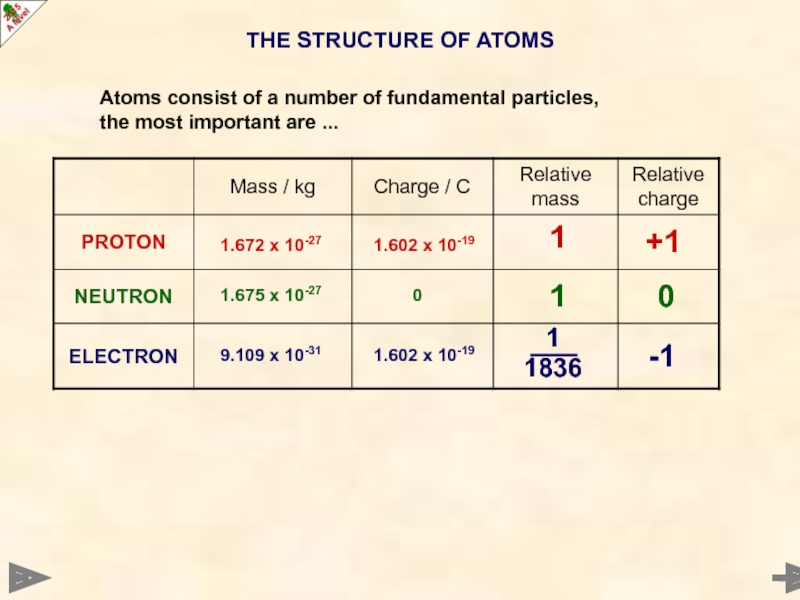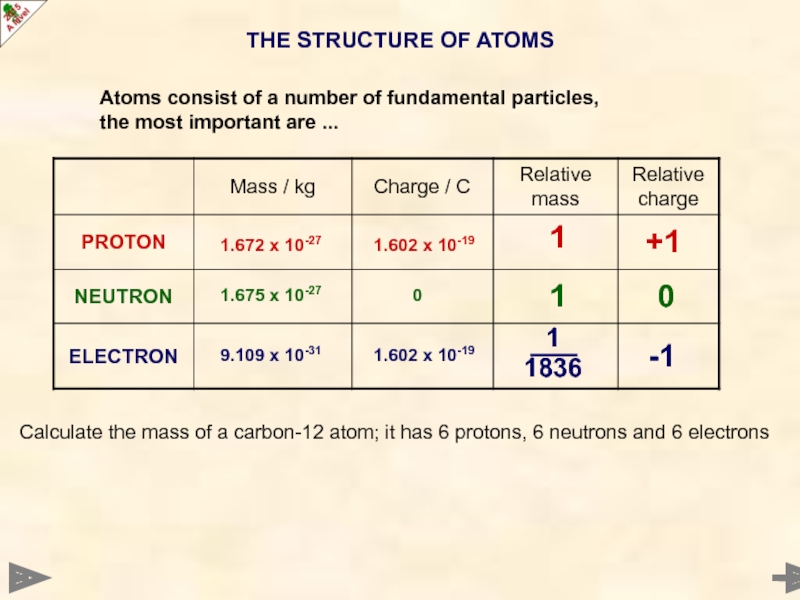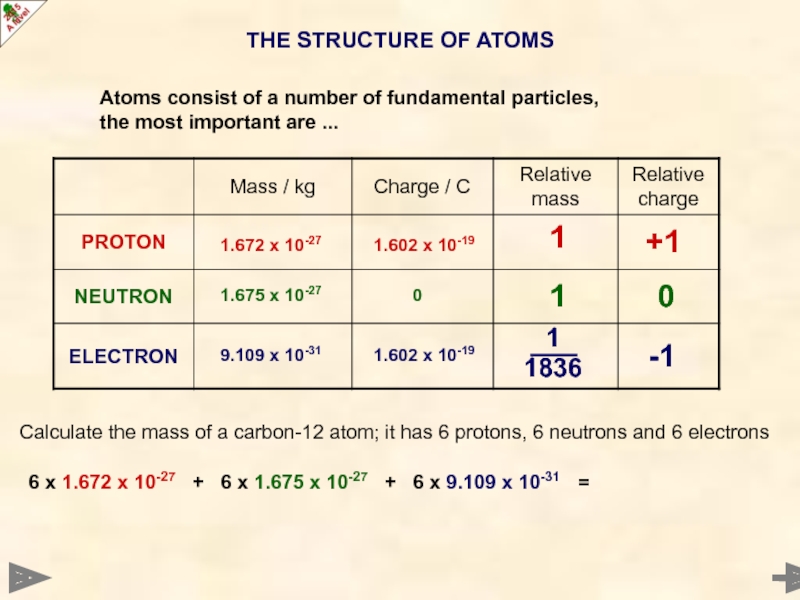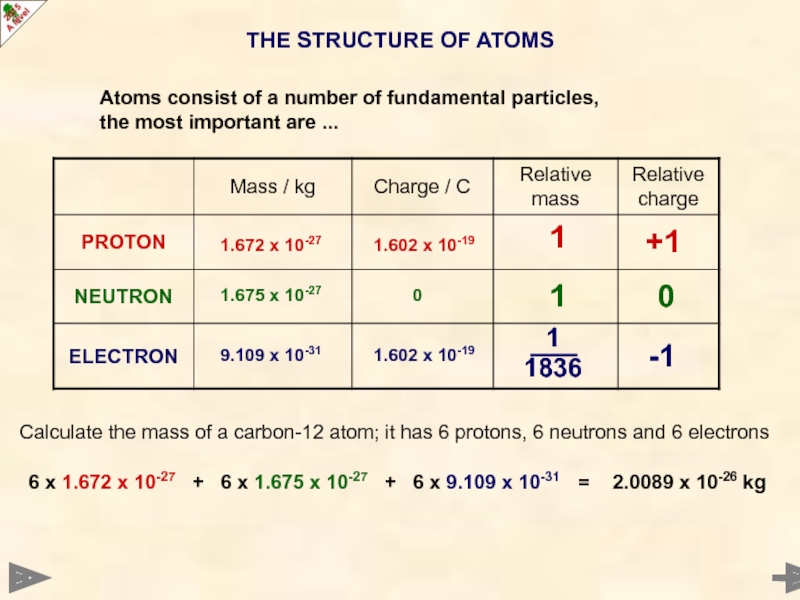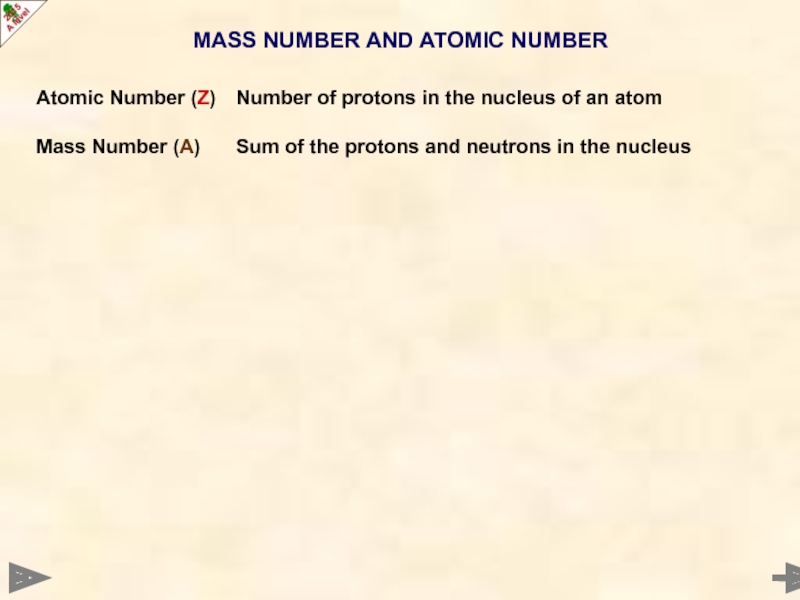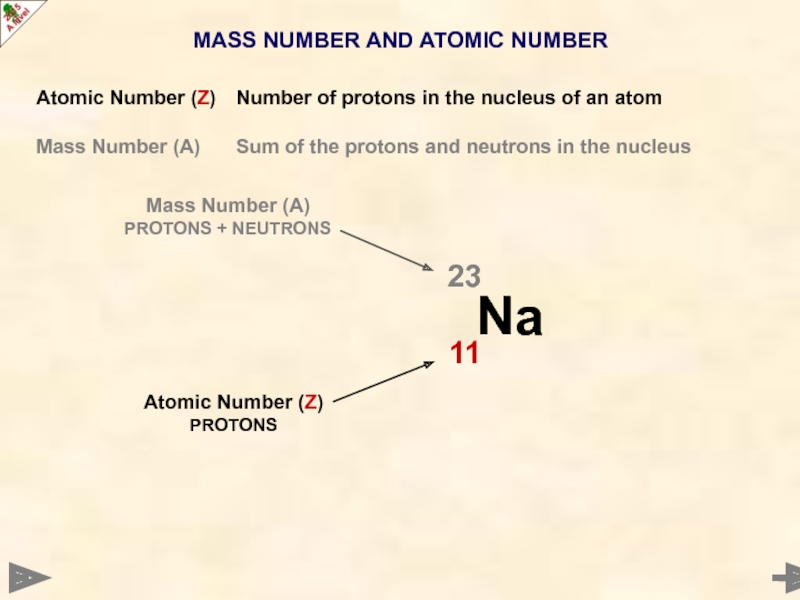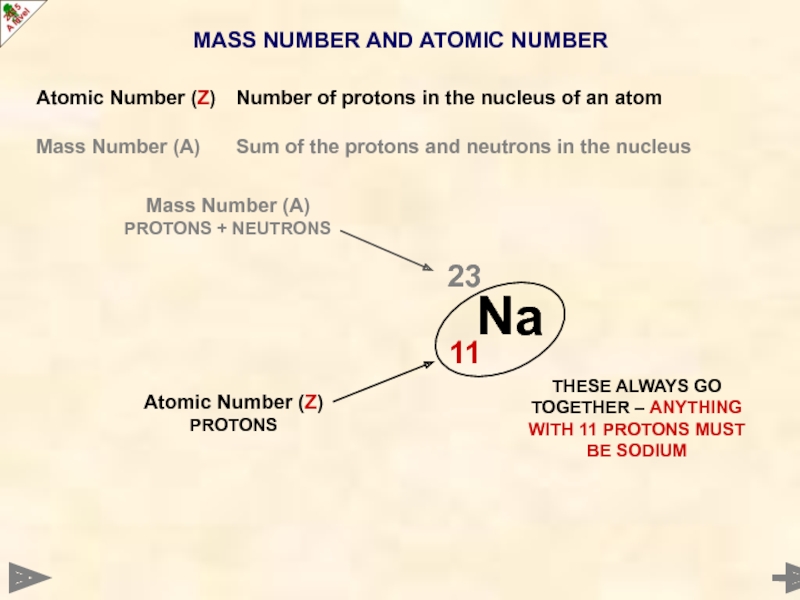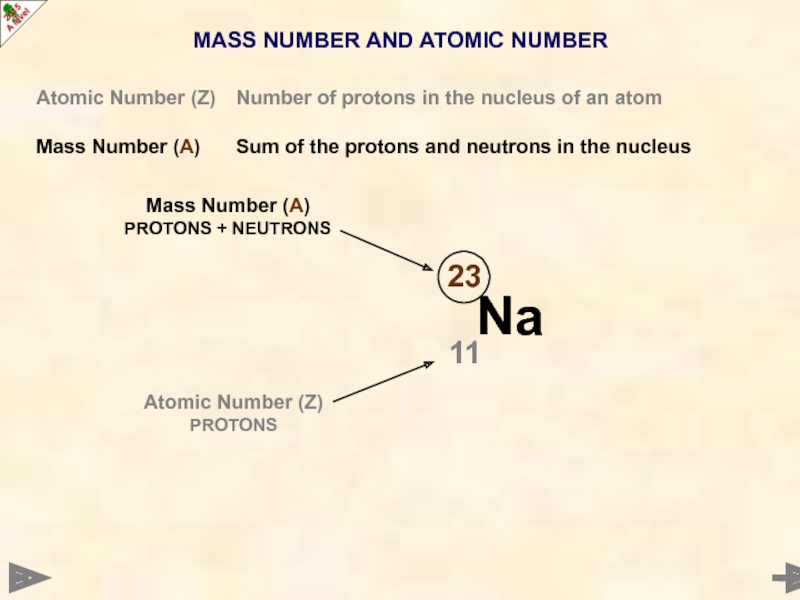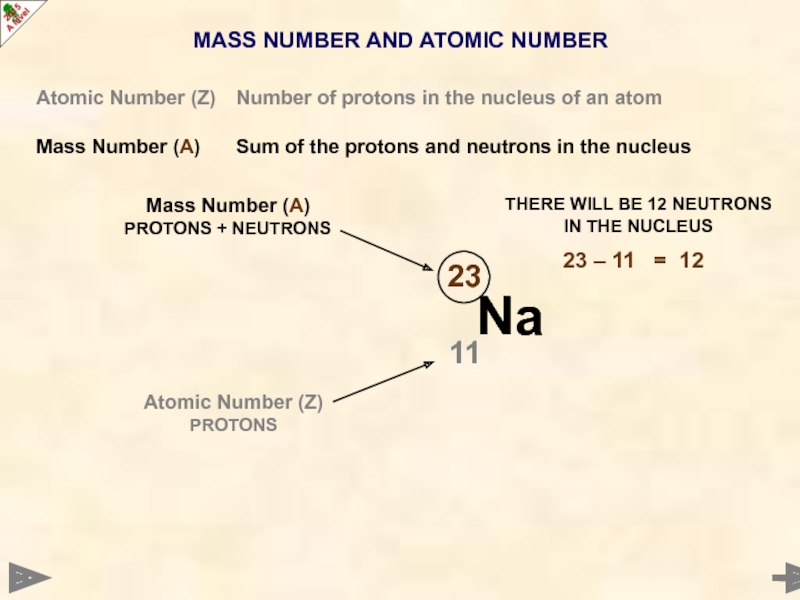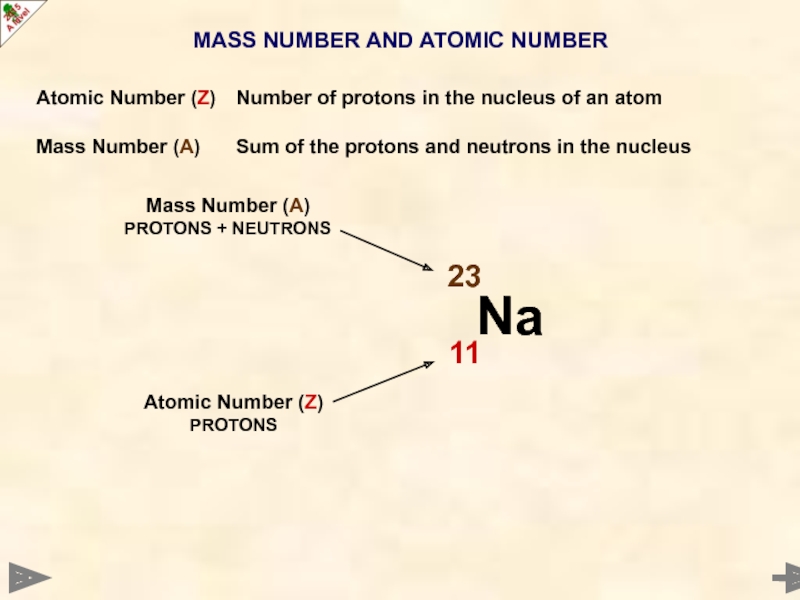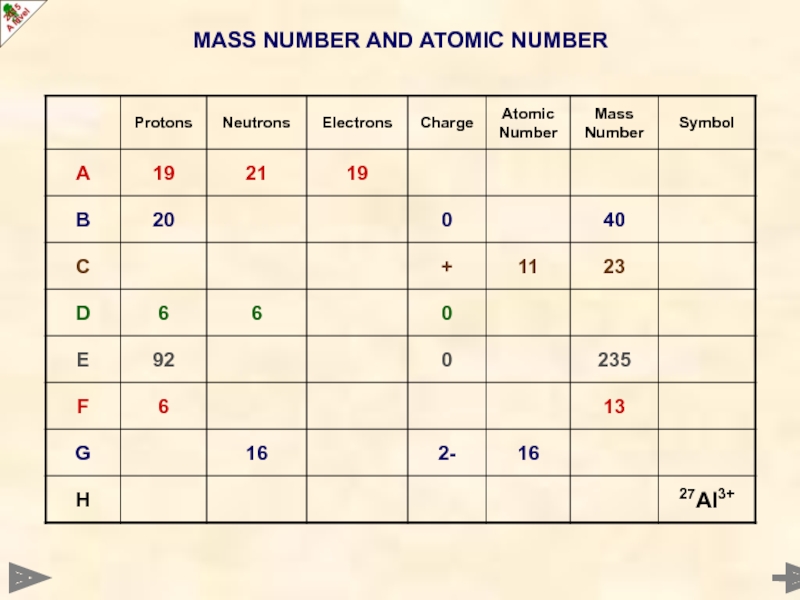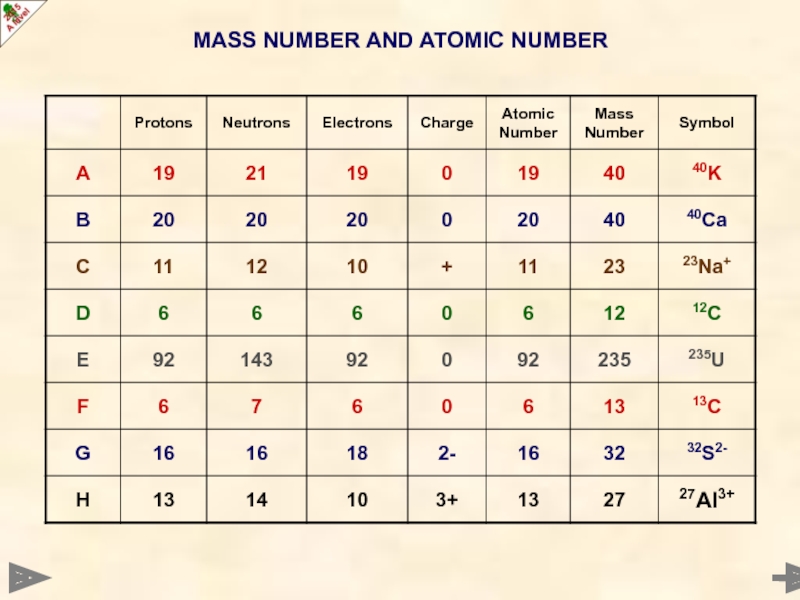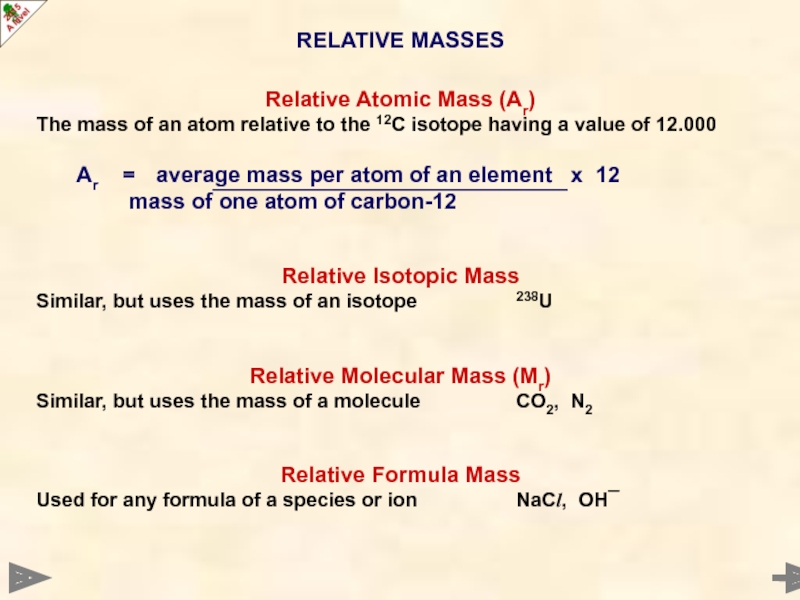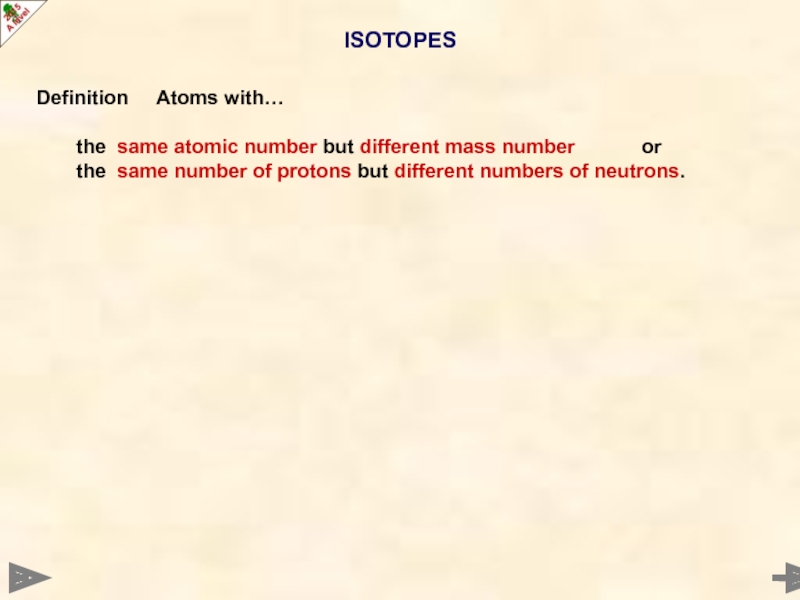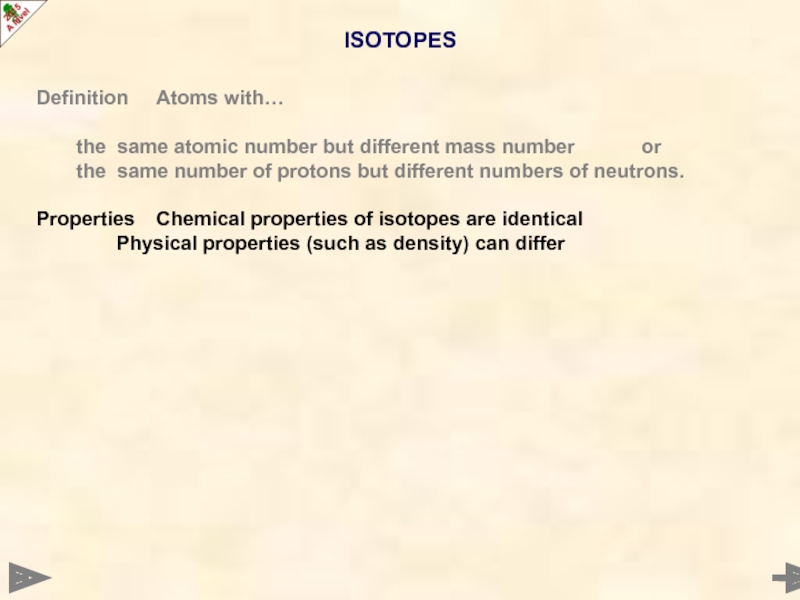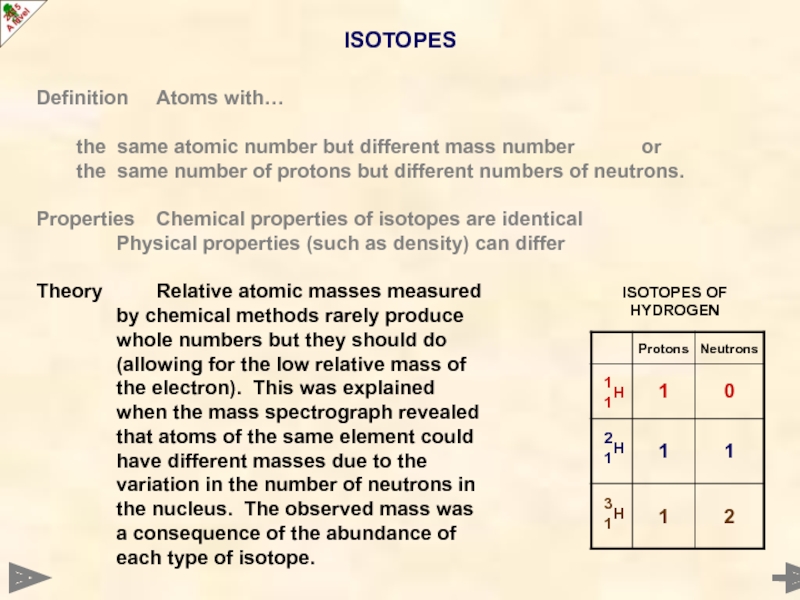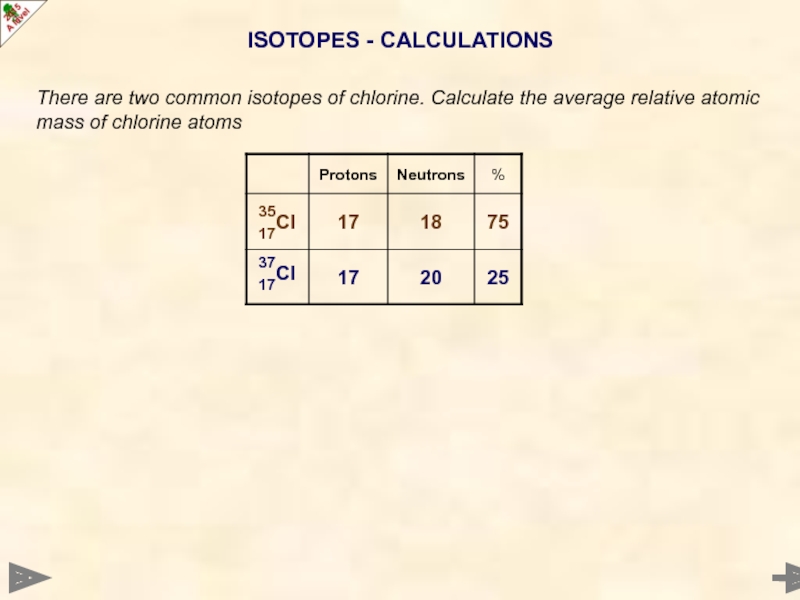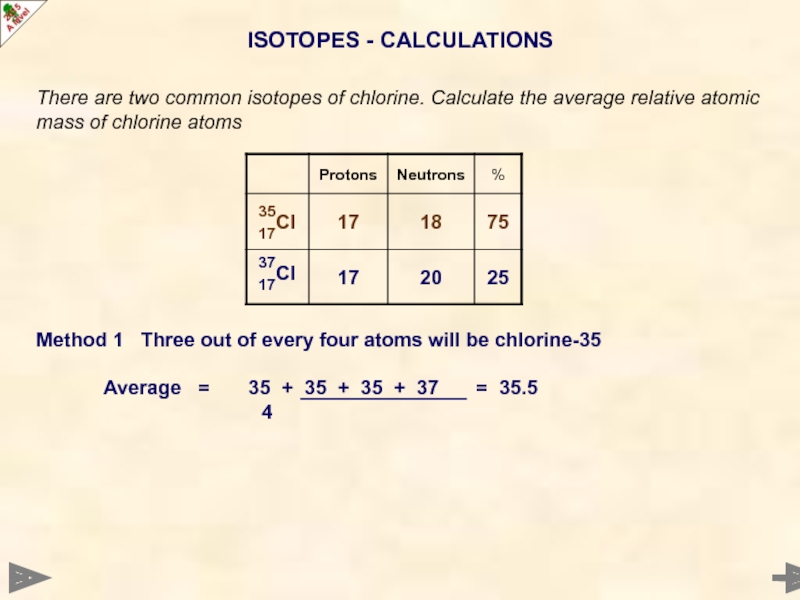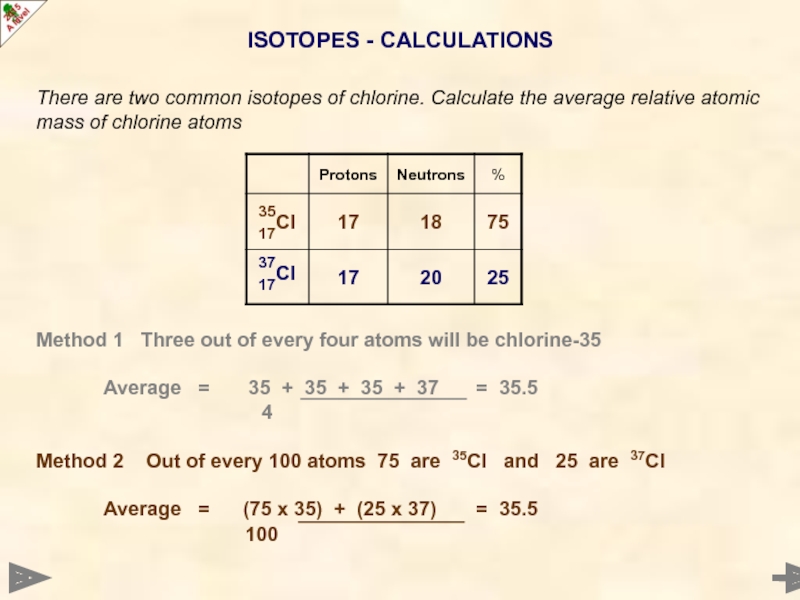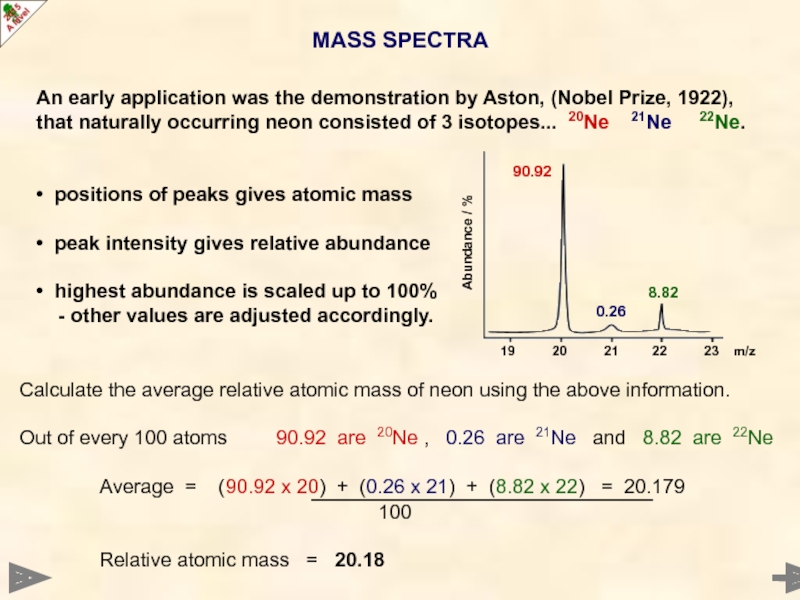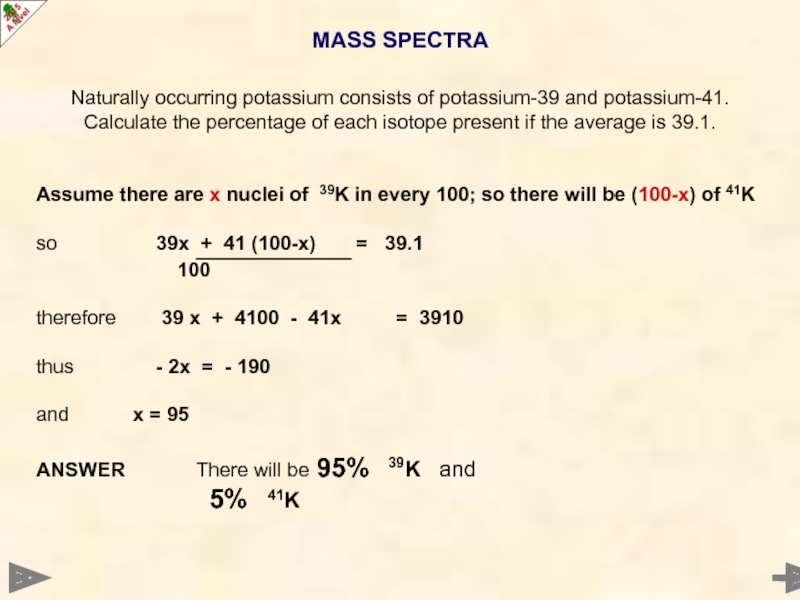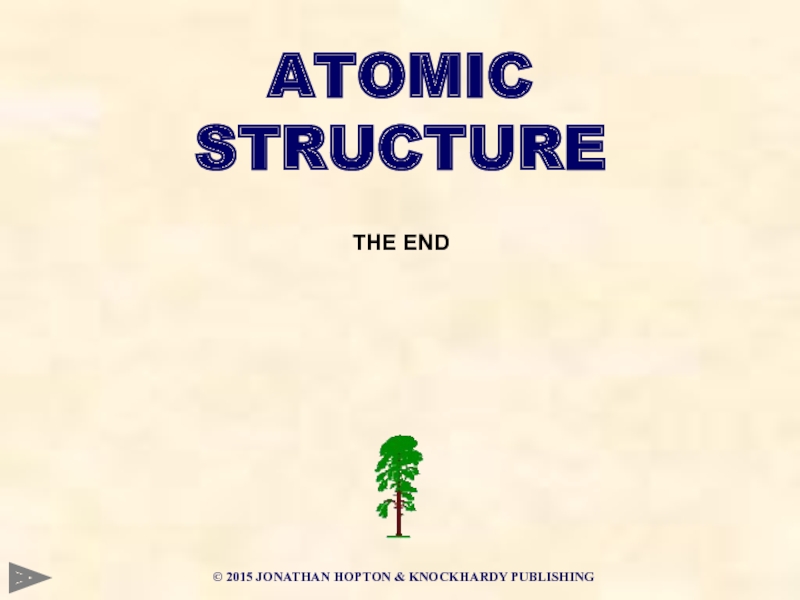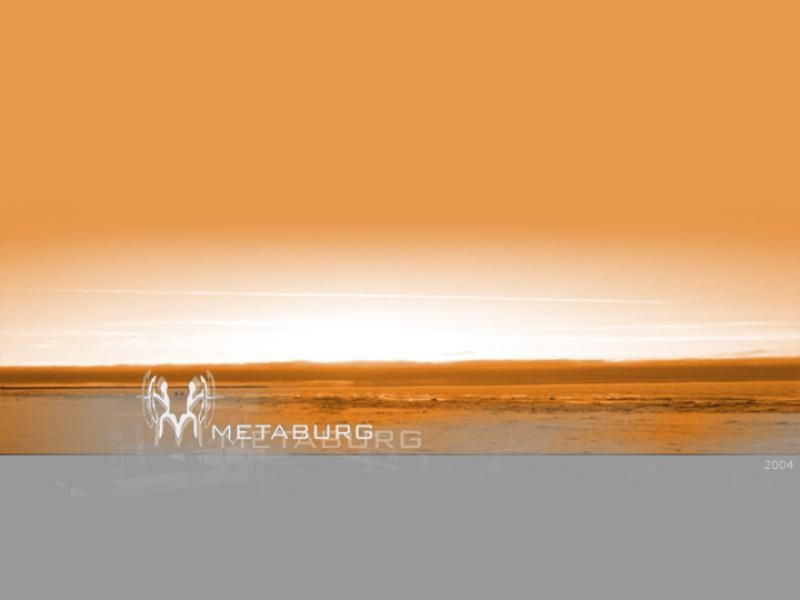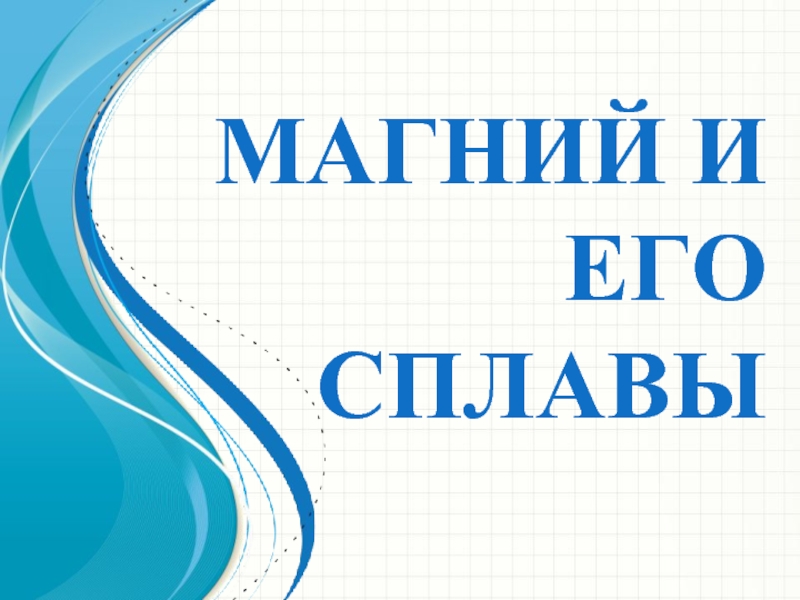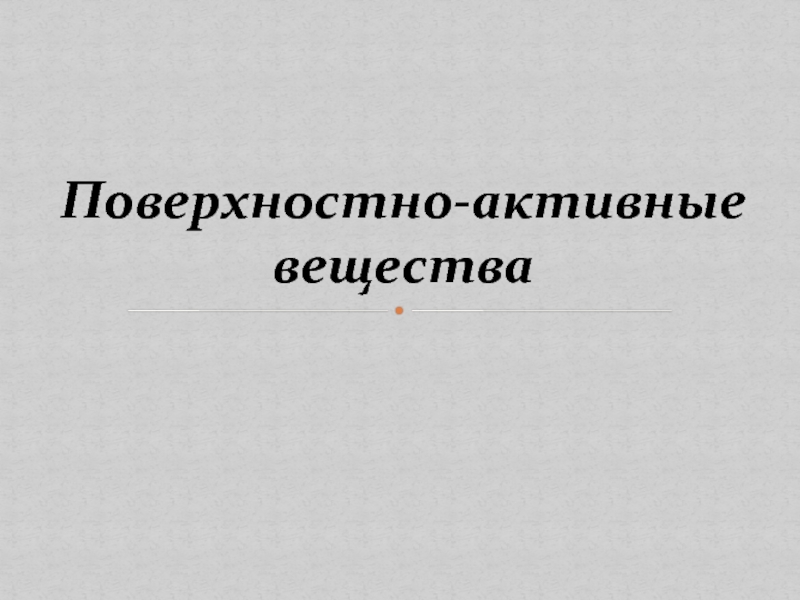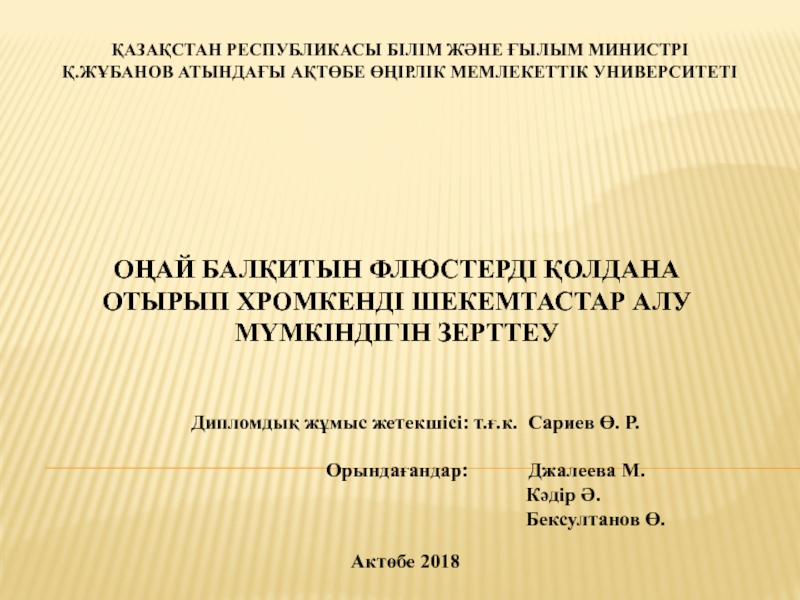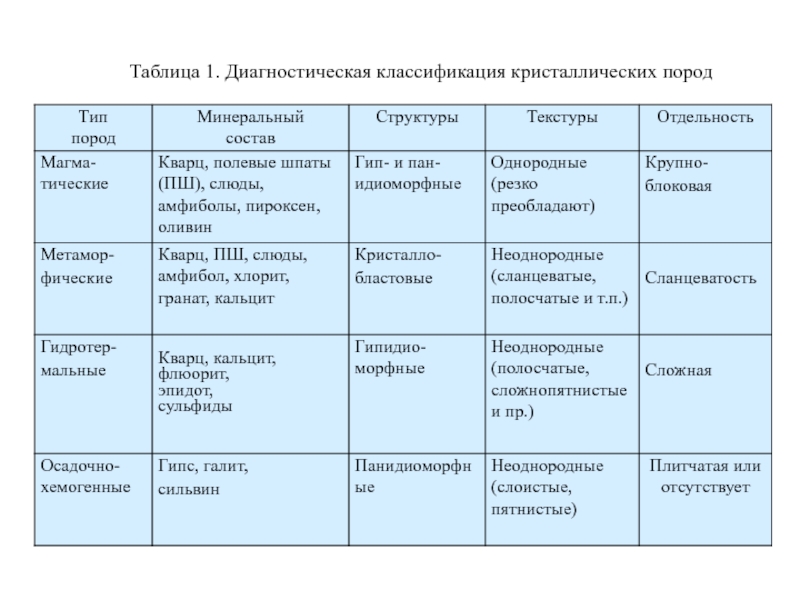- Главная
- Разное
- Дизайн
- Бизнес и предпринимательство
- Аналитика
- Образование
- Развлечения
- Красота и здоровье
- Финансы
- Государство
- Путешествия
- Спорт
- Недвижимость
- Армия
- Графика
- Культурология
- Еда и кулинария
- Лингвистика
- Английский язык
- Астрономия
- Алгебра
- Биология
- География
- Детские презентации
- Информатика
- История
- Литература
- Маркетинг
- Математика
- Медицина
- Менеджмент
- Музыка
- МХК
- Немецкий язык
- ОБЖ
- Обществознание
- Окружающий мир
- Педагогика
- Русский язык
- Технология
- Физика
- Философия
- Химия
- Шаблоны, картинки для презентаций
- Экология
- Экономика
- Юриспруденция
Atomic structure. Introduction презентация
Содержание
- 1. Atomic structure. Introduction
- 2. ATOMIC STRUCTURE INTRODUCTION This Powerpoint show is
- 3. THE STRUCTURE OF ATOMS Atoms consist of
- 4. THE STRUCTURE OF ATOMS 0
- 5. THE STRUCTURE OF ATOMS 0
- 6. THE STRUCTURE OF ATOMS 0
- 7. THE STRUCTURE OF ATOMS 0
- 8. MASS NUMBER AND ATOMIC NUMBER Atomic Number
- 9. MASS NUMBER AND ATOMIC NUMBER Atomic Number
- 10. MASS NUMBER AND ATOMIC NUMBER Atomic Number
- 11. MASS NUMBER AND ATOMIC NUMBER Atomic Number
- 12. MASS NUMBER AND ATOMIC NUMBER Atomic Number
- 13. MASS NUMBER AND ATOMIC NUMBER Atomic Number
- 14. MASS NUMBER AND ATOMIC NUMBER
- 15. MASS NUMBER AND ATOMIC NUMBER
- 16. RELATIVE MASSES Relative Atomic Mass (Ar) The
- 17. ISOTOPES Definition Atoms with… the same atomic
- 18. ISOTOPES Definition Atoms with… the same atomic
- 19. ISOTOPES Definition Atoms with… the same atomic
- 20. ISOTOPES - CALCULATIONS There are two common
- 21. ISOTOPES - CALCULATIONS There are two common
- 22. ISOTOPES - CALCULATIONS There are two common
- 23. MASS SPECTRA An early application was the
- 24. MASS SPECTRA Naturally occurring potassium consists of
- 25. ATOMIC STRUCTURE THE END © 2015 JONATHAN HOPTON & KNOCKHARDY PUBLISHING
Слайд 2ATOMIC STRUCTURE
INTRODUCTION
This Powerpoint show is one of several produced to help
Individual students may use the material at home for revision purposes or it may be used for classroom teaching if an interactive white board is available.
Accompanying notes on this, and the full range of AS and A2 topics, are available from the KNOCKHARDY SCIENCE WEBSITE at...
www.knockhardy.org.uk/sci.htm
Navigation is achieved by...
either clicking on the grey arrows at the foot of each page
or using the left and right arrow keys on the keyboard
Слайд 3THE STRUCTURE OF ATOMS
Atoms consist of a number of fundamental particles,
the
Слайд 4THE STRUCTURE OF ATOMS
0
-1
+1
1
1
1836
1
9.109 x 10-31
1.602 x 10-19
1.672 x 10-27
1.602 x
1.675 x 10-27
0
Atoms consist of a number of fundamental particles,
the most important are ...
Слайд 5THE STRUCTURE OF ATOMS
0
-1
+1
1
1
1836
1
Calculate the mass of a carbon-12 atom; it
9.109 x 10-31
1.602 x 10-19
1.672 x 10-27
1.602 x 10-19
1.675 x 10-27
0
Atoms consist of a number of fundamental particles,
the most important are ...
Слайд 6THE STRUCTURE OF ATOMS
0
-1
+1
1
1
1836
1
Calculate the mass of a carbon-12 atom; it
9.109 x 10-31
1.602 x 10-19
1.672 x 10-27
1.602 x 10-19
1.675 x 10-27
0
6 x 1.672 x 10-27 + 6 x 1.675 x 10-27 + 6 x 9.109 x 10-31 =
Atoms consist of a number of fundamental particles,
the most important are ...
Слайд 7THE STRUCTURE OF ATOMS
0
-1
+1
1
1
1836
1
Calculate the mass of a carbon-12 atom; it
9.109 x 10-31
1.602 x 10-19
1.672 x 10-27
1.602 x 10-19
1.675 x 10-27
0
6 x 1.672 x 10-27 + 6 x 1.675 x 10-27 + 6 x 9.109 x 10-31 = 2.0089 x 10-26 kg
Atoms consist of a number of fundamental particles,
the most important are ...
Слайд 8MASS NUMBER AND ATOMIC NUMBER
Atomic Number (Z) Number of protons in the
Mass Number (A) Sum of the protons and neutrons in the nucleus
Слайд 9MASS NUMBER AND ATOMIC NUMBER
Atomic Number (Z) Number of protons in the
Mass Number (A) Sum of the protons and neutrons in the nucleus
Mass Number (A)
PROTONS + NEUTRONS
Atomic Number (Z)
PROTONS
Слайд 10MASS NUMBER AND ATOMIC NUMBER
Atomic Number (Z) Number of protons in the
Mass Number (A) Sum of the protons and neutrons in the nucleus
Mass Number (A)
PROTONS + NEUTRONS
Atomic Number (Z)
PROTONS
THESE ALWAYS GO TOGETHER – ANYTHING WITH 11 PROTONS MUST BE SODIUM
Слайд 11MASS NUMBER AND ATOMIC NUMBER
Atomic Number (Z) Number of protons in the
Mass Number (A) Sum of the protons and neutrons in the nucleus
Mass Number (A)
PROTONS + NEUTRONS
Atomic Number (Z)
PROTONS
Слайд 12MASS NUMBER AND ATOMIC NUMBER
Atomic Number (Z) Number of protons in the
Mass Number (A) Sum of the protons and neutrons in the nucleus
Mass Number (A)
PROTONS + NEUTRONS
Atomic Number (Z)
PROTONS
THERE WILL BE 12 NEUTRONS IN THE NUCLEUS
23 – 11 = 12
Слайд 13MASS NUMBER AND ATOMIC NUMBER
Atomic Number (Z) Number of protons in the
Mass Number (A) Sum of the protons and neutrons in the nucleus
Mass Number (A)
PROTONS + NEUTRONS
Atomic Number (Z)
PROTONS
Слайд 16RELATIVE MASSES
Relative Atomic Mass (Ar)
The mass of an atom relative to
Ar = average mass per atom of an element x 12
mass of one atom of carbon-12
Relative Isotopic Mass
Similar, but uses the mass of an isotope 238U
Relative Molecular Mass (Mr)
Similar, but uses the mass of a molecule CO2, N2
Relative Formula Mass
Used for any formula of a species or ion NaCl, OH¯
Слайд 17ISOTOPES
Definition Atoms with…
the same atomic number but different mass number
the same number of protons but different numbers of neutrons.
Слайд 18ISOTOPES
Definition Atoms with…
the same atomic number but different mass number
the same number of protons but different numbers of neutrons.
Properties Chemical properties of isotopes are identical
Physical properties (such as density) can differ
Слайд 19ISOTOPES
Definition Atoms with…
the same atomic number but different mass number
the same number of protons but different numbers of neutrons.
Properties Chemical properties of isotopes are identical
Physical properties (such as density) can differ
Theory Relative atomic masses measured
by chemical methods rarely produce
whole numbers but they should do
(allowing for the low relative mass of
the electron). This was explained
when the mass spectrograph revealed
that atoms of the same element could
have different masses due to the
variation in the number of neutrons in
the nucleus. The observed mass was
a consequence of the abundance of
each type of isotope.
ISOTOPES OF HYDROGEN
Слайд 20ISOTOPES - CALCULATIONS
There are two common isotopes of chlorine. Calculate the
Слайд 21ISOTOPES - CALCULATIONS
There are two common isotopes of chlorine. Calculate the
Method 1 Three out of every four atoms will be chlorine-35
Average = 35 + 35 + 35 + 37 = 35.5
4
Слайд 22ISOTOPES - CALCULATIONS
There are two common isotopes of chlorine. Calculate the
Method 1 Three out of every four atoms will be chlorine-35
Average = 35 + 35 + 35 + 37 = 35.5
4
Method 2 Out of every 100 atoms 75 are 35Cl and 25 are 37Cl
Average = (75 x 35) + (25 x 37) = 35.5
100
Слайд 23MASS SPECTRA
An early application was the demonstration by Aston, (Nobel Prize,
• positions of peaks gives atomic mass
• peak intensity gives relative abundance
• highest abundance is scaled up to 100%
- other values are adjusted accordingly.
Calculate the average relative atomic mass of neon using the above information.
Out of every 100 atoms 90.92 are 20Ne , 0.26 are 21Ne and 8.82 are 22Ne
Average = (90.92 x 20) + (0.26 x 21) + (8.82 x 22) = 20.179
100
Relative atomic mass = 20.18
Слайд 24MASS SPECTRA
Naturally occurring potassium consists of potassium-39 and potassium-41.
Calculate the percentage
Assume there are x nuclei of 39K in every 100; so there will be (100-x) of 41K
so 39x + 41 (100-x) = 39.1
100
therefore 39 x + 4100 - 41x = 3910
thus - 2x = - 190
and x = 95
ANSWER There will be 95% 39K and
5% 41K

